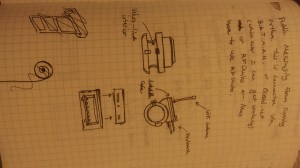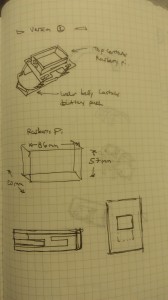Purpose: To explore alternative networks and engage in current discourse by creating a project for raspberry pi + mesh network.
Concept: Build a mesh-capable, mobile Raspberry Pi with an accompanying should strap/holster for easy portability of the pi as well as a simple chat application.
Target:
- People who are already aware of network infrastructure.
- People who are code literate.
- People who want greater online privacy.
- People interested in exploring alternative communication.
- People who care about preserving democracy.
- Urban explorers.
- Tech hobbyists/enthusiasts.
Research: Lots and lots of research.
- Mesh networks/communities/software
-
http://subnodes.org/ (mesh)
-
https://github.com/WachterJud/qaul.net (mesh)
-
http://www.open-mesh.org/projects/batman-adv/wiki/Quick-start-guide (mesh)
-
https://nycmesh.net/ (mesh)
- https://code.google.com/p/fabfi/ (mesh)
-
http://www.backslash.cc/ (mesh)
-
http://radicalnetworks.org/ (community)
- http://www.openbsd.org/cgi-bin/man.cgi/OpenBSD-current/man8/hostapd.8?query=hostapd&arch=i386 (software)
- http://www.thekelleys.org.uk/dnsmasq/doc.html (software).
-
- Tutorials:
- http://elinux.org/RPi_USB_Wi-Fi_Adapters (list of all raspi supported dongles)
- http://raspberry-at-home.com/hotspot-wifi-access-point/ (tutorial on raspi as AP)
- https://learn.adafruit.com/setting-up-a-raspberry-pi-as-a-wifi-access-point/overview (another tutorial on setting up raspi as AP)
-
https://bogeskov.dk/UsbAccessPoint.html (for rtl8192cu drivers)
- https://nims11.wordpress.com/2012/04/27/hostapd-the-linux-way-to-create-virtual-wifi-access-point/ (hostapd tutorial)
- https://nims11.wordpress.com/2013/05/22/using-hostapd-with-dnsmasq-to-create-virtual-wifi-access-point-in-linux/ (dnsmasq tutorial)
- http://hackaday.com/2012/11/14/mesh-networking-with-multiple-raspberry-pi-boards/
- dongles used/tested
-
TP-LINK WN725N (did not work)
- OLIMEX rtl5370 (produced SSID, no connection)
- LB-Link 802.lln wifi usb (produced SSID, no connection)
- TP-LINK WR702n (purchased, did not test)
-
- Database used:
- http://redis.io/ (for raspberry pi) because it runs locally, requires no connection to the cloud or star network service.
Design Process:
- Iteration 1 – http://portfolio.newschool.edu/demcg318/2015/11/02/portable-meshpi-prototype-1/
- Iteration 2 – http://portfolio.newschool.edu/demcg318/2015/11/02/portable-meshpi-prototype-2/
- Iteration 3
- Moved away from building arm-mounted raspberry pi holders towards something more like a detectives gun holster. The shoulder strap also comes with an attachable 21w solar panel and a small satchel/backpack to carry various accessories (dongles, batteries, hard drives, replacement parts, etc…)
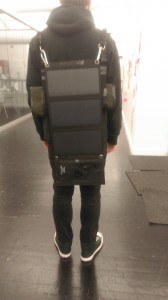
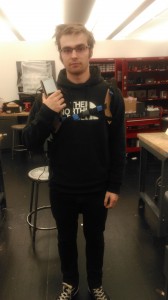
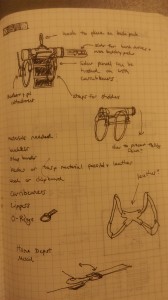
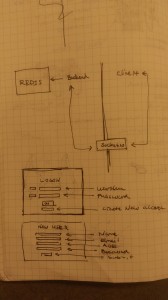
- Benefits include:
- Greater distribution of weight
- concealable/not as conspicuous
- modular. other items/accessories can be attached as necessary.
- Some problems:
- weight issues. The more components you attach to the back of the holster, the heavier it gets and the more it sags in the back.
- cardboard construction. weak, prone to breakage.
- usb power cord attached to raspi is a tad awkward/prone to tangles.
- case for raspberry pi needs more thought/design
- Future iteration:
- leather or synthetic strap construction
- work with fashion designer to sew and work out sagging issue
- construct a better satchel. Experiment with weather proof materials
- experiment with raspberry pi case design. Move beyond cardboard.
Challenges:
- Setting up mesh on raspberry pi. Kernel drivers aren’t fully supportive of ad-hoc mode.
- wifi dongles get very hot.
- creating chat history with Redis database and pulling history in order to populate the webpage whenever a new user joins.
- sewing – I am by no means skilled in any way at sewing. I have minimal experience and definitely need to find tutorials or seek assistance.
Conclusion/next step:
- This project required lots and lots of research on the the topic of networks before I was able to start engaging with the topic through a project. Researching all of this stuff confirmed my ignorance on the topic, but also generated lots of interest. When asking People about my engagement with mesh networks, they saw lots of value in the project, however, many weren’t entirely sure what kind of project could be made, other than instantiating a mesh node. Perhaps a future project might involve questions like: “how can I bring awareness and adoption of mesh networks to more average internet users?” or “What sort of applications could I build that would be exclusive to mesh networks? How could such applications be used to generate interest and adoption?” According to my ethnographic research, people were hesitant to join because it only works if many people are on it. People also weren’t absolutely sure that mesh networks are the solution to their privacy problems. So there are lots of questions for future engagement and I think next steps would be to dive into the communities already established around mesh networking to see what’s going on and how I can help.
Google slides presentation:
- https://docs.google.com/presentation/d/1CGuNh5DNDDObzshei2RHpZrjphAnT8JmWWBQhe7ZH8s/edit?usp=sharing
Link to Github repo:
edit: pictures.
